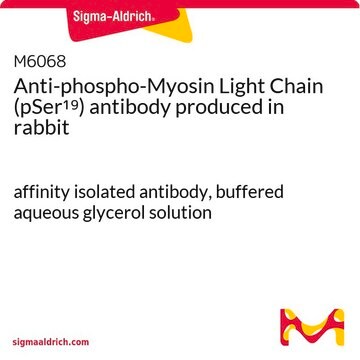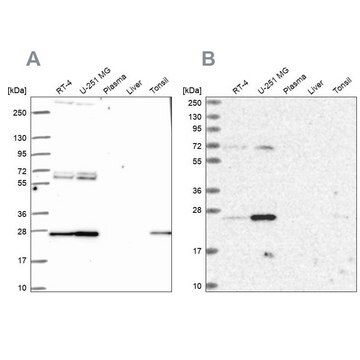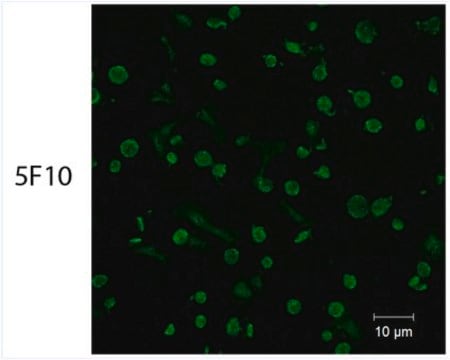推薦產品
生物源
rabbit
品質等級
共軛
unconjugated
抗體表格
affinity isolated antibody
抗體產品種類
primary antibodies
無性繁殖
polyclonal
形狀
buffered aqueous solution
分子量
antigen 41 kDa
物種活性
mouse, rat, human
濃度
~1 mg/mL
技術
ELISA: 1:10000
immunofluorescence: 1:100-1:500
western blot: 1:500-1:1000
NCBI登錄號
UniProt登錄號
運輸包裝
wet ice
儲存溫度
−20°C
目標翻譯後修改
unmodified
基因資訊
human ... F2RL3(9002)
一般說明
Anti-PAR4 Antibody detects endogenous levels of total PAR4 protein.
F2R-like thrombin or trypsin receptor 3/coagulation factor 2 receptor-like 3 (F2RL3) gene codes for protease-activated receptor 4 (PAR4) protein. PAR4 belongs to the G protein-coupled receptors (GPCRs) family. It is expressed at high levels in the lungs, pancreas, thyroid, testis, and small intestine. PAR4 gene is located on human chromosome 19p12. Anti-PAR4 antibody detects endogenous levels of total PAR4 protein.
免疫原
The antiserum was produced against synthesized peptide derived from human PAR4.
Immunogen Range: 29-78
Immunogen Range: 29-78
應用
Anti-PAR4 antibody produced in rabbit has been used in immunoblotting (1:1000).
生化/生理作用
Protease-activated receptor 4 (PAR4) protein is involved in vascular inflammation. It is necessary for a stable thrombus as it mediates persistent thrombin signaling in platelets. PAR4 aids pro-inflammatory actions by interacting with the bradykinin B2 receptor. It is linked to renal function and the development of chronic kidney disease (CKD).
特點和優勢
Evaluate our antibodies with complete peace of mind. If the antibody does not perform in your application, we will issue a full credit or replacement antibody. Learn more.
外觀
Rabbit IgG in phosphate buffered saline (without Mg2+ and Ca2+), pH 7.4, 150mM NaCl, 0.02% sodium azide and 50% glycerol.
免責聲明
Unless otherwise stated in our catalog or other company documentation accompanying the product(s), our products are intended for research use only and are not to be used for any other purpose, which includes but is not limited to, unauthorized commercial uses, in vitro diagnostic uses, ex vivo or in vivo therapeutic uses or any type of consumption or application to humans or animals.
未找到適合的產品?
試用我們的產品選擇工具.
儲存類別代碼
10 - Combustible liquids
水污染物質分類(WGK)
nwg
閃點(°F)
Not applicable
閃點(°C)
Not applicable
Dian Ningtyas et al.
Frontiers in genetics, 11, 432-432 (2020-05-20)
The F2RL3 gene encoding protease activated receptor 4 (PAR4) contains a single nucleotide variant, rs773902, that is functional. The resulting PAR4 variants, Thr120, and Ala120, are known to differently affect platelet reactivity to thrombin. Significant population differences in the frequency
Xu Han et al.
Blood, 136(19), 2217-2228 (2020-06-24)
Protease-activated receptor 4 (PAR4) mediates sustained thrombin signaling in platelets and is required for a stable thrombus. PAR4 is activated by proteolysis of the N terminus to expose a tethered ligand. The structural basis for PAR4 activation and the location
Gamariel Rwibasira Rudinga et al.
International journal of molecular sciences, 19(2) (2018-02-15)
Cardiovascular diseases (CVDs) are currently among the leading causes of death worldwide. Platelet aggregation is a key cellular component of arterial thrombi and major cause of CVDs. Protease-activated receptors (PARs), including PAR1, PAR2, PAR3 and PAR4, fall within a subfamily
Simeng Li et al.
International journal of molecular sciences, 20(22) (2019-11-14)
Protease-activated receptors (PARs) are a family of four GPCRs with a variety of cellular functions, yet the only advanced clinical endeavours to target these receptors for therapeutic gain to date relates to the impairment of platelet function for anti-thrombotic therapy.
Dorothea M Heuberger et al.
Thrombosis journal, 17, 4-4 (2019-04-13)
Inflammatory diseases have become increasingly prevalent with industrialization. To address this, numerous anti-inflammatory agents and molecular targets have been considered in clinical trials. Among molecular targets, protease-activated receptors (PARs) are abundantly recognized for their roles in the development of chronic
我們的科學家團隊在所有研究領域都有豐富的經驗,包括生命科學、材料科學、化學合成、色譜、分析等.
聯絡技術服務








